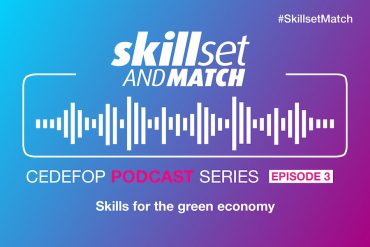The European Green Deal will lead to the creation of about 2.5 million additional jobs in the European Union, provided that its targets are met, and securing quality jobs and sufficient skills is pivotal to making this happen.
This was the main message conveyed by Cedefop Deputy Director Mara Brugia to participants in a conference entitled ‘The Green Deal as the EU growth strategy’, organised by SGI Europe and the European Economic and Social Committee in Brussels on 20 November.
As the European Year of Skills is in full swing, Ms Brugia spoke during a panel discussion on upskilling and reskilling the European Union's workforce for the green transition and also noted that to reach the objectives of the Green Deal it is crucial to understand the key skills necessary for reaching a circular economy.
Cedefop findings, she added, suggests that skills for the green transition are in fact a blend of technical and soft skills, job-specific and transversal skills, and that there is a strong link between the digital and the green transition, given that in most key occupations for the green transition, the design, development and use of technology, as well as digital skills are crucial.
Green drivers
She went on to list the occupations that are most important for the green transition, as they transpire from Cedefop’s research:
- Key green occupations, i.e. those who work on the frontline of the green transition;
- occupations developing green technologies, and managers that need to adjust or develop new business models;
- occupations that may be small in terms of employment shares, but nevertheless indispensable for achieving the green transition – ‘thyroid’ or niche occupations.
Fresh employment opportunities are expected to emerge not only in high-skilled jobs, but also in middle-skilled occupations with more technical profiles, such as offshore renewable energy plant operators and biogas technicians, and low-skilled roles, e.g. in the waste management sector, Ms Brugia said and further outlined the dual role that vocational education and training (VET) can play to enable the green
- In the short-term, VET can accompany the changes taking place, by quickly addressing emerging skill demands, for example via short courses.
- In the longer term, VET can embed the circularity concept in existing curricula and programmes and design new ones where necessary; it also means attracting young people to green learning pathways. Thus, VET does not simply accompany the changes, it triggers change and fosters innovation.
‘But VET is not a panacea. Shortages are not only a skills supply issue, we need to create high-quality jobs, make them more attractive, not only in terms of remuneration and working conditions, but also allowing people to make full use of their potential’, Ms Brugia pointed out, adding that this necessitates more green skills anticipation to enable evidence-based policy and decision making and a comprehensive skills governance to understand in a timely manner the implications of the green transition for skills and jobs.




